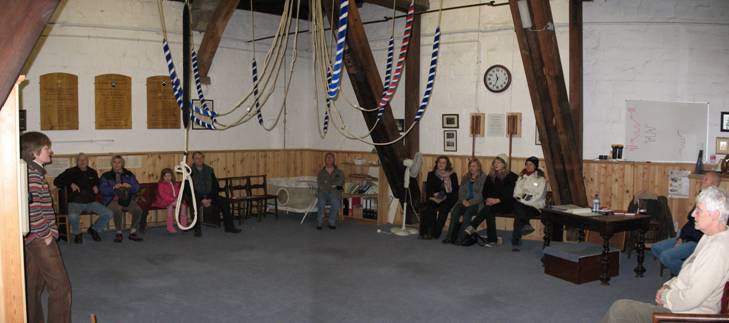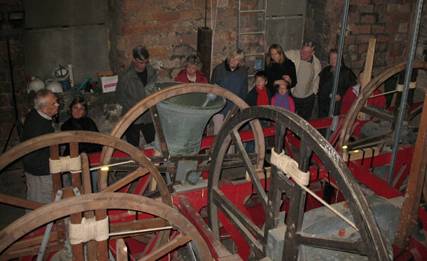A Ringing Guide for non-ringers
Non ringers may be interested to know when the bells are going to be ringing, and why, and perhaps who is ringing them. Some bell ringing terms may be baffling. Follow the links for explanations.
Standard Ringing Times
Thursdays: We practise 19:15 to 21:00 on a Thursday evening. This is for as many of our band as are available, plus any visitors. You will hear ringing on 6, 8 or 10 bells, with brief silences while the ringers change over. The practice tends to start with simpler things on 6 bells, and progresses to more complex things on 8 or 10 bells.
Sundays: We ring for morning service (09:20 to 09:55) and for Evensong (17:30 to 18:25). We try to maintain a high standard of ringing on Sundays. Normally ringers will take it in turns to ring (called general ringing) but occasionally we will ring a continuous piece for Evensong known as a quarter peal, and any of these are shown on our Ringing Calendar.
Other Reasons for Ringing
The bells at Hexham may be rung for all sorts of reasons in addition to the weekly practice and service ringing mentioned above. Some examples are given below:
- weddings, and occasionally funerals
- additional weekday services eg: Ascension Day
- opening, or rung as a part of, the Abbey Festival
- half-muffled for the Cenotaph Service on Remembrance Day
- for events of national importance
- area ringers' events, eg: meetings, striking competitions, peals
- local ringers' events, eg: additional practices, quarter peals
- ringers visiting from outside the area
The ringers' events may be partly organised for pleasure, but they are also an essential part of maintaining a band of ringers that ring for services at a high standard. Periods of sustained ringing – peals and quarter peals – are particularly useful for this.
Our Policy on Sound Control
We hope that people in Hexham like to listen to the bells, particularly if the ringing is of a high standard, but understand that one can still have too much of a good thing, particularly at certain times. To try to avoid the bells becoming a nuisance, rather than a pleasure, we do the following:
- teach our learners on bells with clappers fixed (i.e. silently), and take good teaching seriously
- hold some silent practices using a simulator
- try to ensure that our ringing is of good quality especially on Sundays
- use our sound control (flaps may be closed to reduce the sound of the bells outside) for additional ringing
- avoid day-time ringing on weekdays and Saturdays, except for services, weddings, and special occasions
- try to space out additional ringing, so there is not too much ringing in a week
- agree all ringing with the Parish Office. If you are organising a local event and are concerned that bells might conflict with it, let the Parish Office know
- avoid organising additional ringing that would conflict with known local events
- have a number that people can call to comment on the bells (this can be found in the Slype in the Abbey, or contact can be made via this website)
Clock Chimes
The Abbey clock is provided and maintained by Hexham town council, and it has mechanical chimes which automatically chime the Abbey bells every quarter of an hour. The heavy chiming hammers have to be lifted clear of the bells before the bells can be rung. Once the bells have been rung "up" into the raised position (mouth upwards), they cannot be chimed by the clock. We would normally ring the bells down after we have finished ringing as it is safer and good practice to do so. We can then put the clock chimes back on. There are exceptions to this. Sometimes it is necessary to leave the bells in the raised position so that they are ready to be rung for another event or service for which there would be insufficient time to ring them up. For example, on a Sunday the bells are normally left "up" between morning ringing and evening ringing, or if the bells are rung on a Friday evening, they may be left up for a wedding the following day. So if the Abbey clock is not chiming, it is likely to be because it has been necessary to leave the bells up.
Ringing Jargon Explained
The Ringing Chamber
The picture below shows the ringing chamber during our open day on 8th December 2007. We have plenty of space, and we have made it quite comfortable. We do spend a lot of time there. Yes, that is a children's play pen in the corner. If you would like to see the ringing chamber and the bells, our annual open day during the Abbey Christmas Fair is a good opportunity. The three boards up on the left hand wall are peal boards: records of peals which have been rung for special occasions in recent years.

The Bells
The picture below was taken in the bell chamber, again on the open day. The bell in the centre of the picture is in the "raised" or "up" position, ready to be rung. All the other bells are down. The people listening to the talk are a safe distance from this bell – there is plenty of space in the bell chamber at Hexham.
